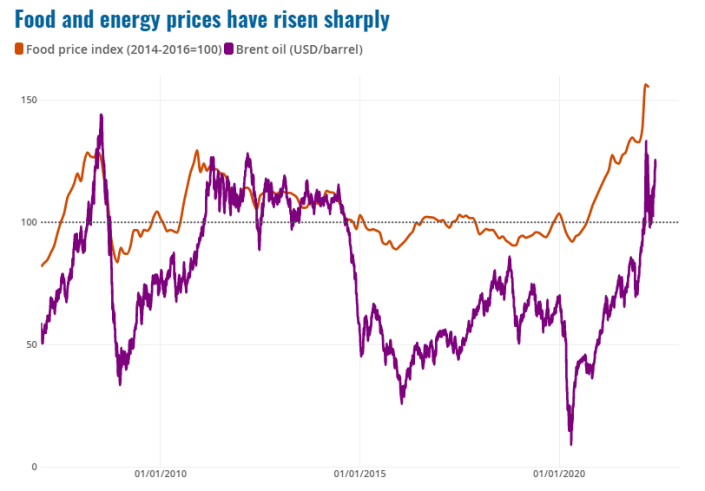It seemed silly, in March, when President Biden started calling persistent inflation “Putin’s price hike.” The price of gasoline and many other things had been soaring well before Putin ordered Russia’s invasion of Ukraine on Feb. 24, and blaming that on Putin all of a sudden was opportunistic blame-shifting.
More than 100 days into the war, however, the Russian president’s belligerence has clearly had the most pronounced effect on global prices of any single geopolitical development since the oil shocks of the 1970s. A new report by the Organization for Economic Cooperation and Development compares current forecasts for inflation, growth, incomes and living standards with forecasts at the end of 2021, to present a before-and-after perspective of how Russia’s warmongering is affecting the entire world economy. The impact is stark and likely to get worse, not better.
The pre-war year-over-year inflation forecast for the 38 OECD member countries was 4.4%. It’s now double that, at 8.8%. The United States, struggling with 8.3% inflation, is actually doing better than many other countries. Eastern European countries near the war zone, such as Poland, Latvia and Estonia, are on track for double-digit inflation. The inflation forecast for the U.K. is 8.8%. In Turkey, already beset by monetary-policy missteps, inflation has skyrocketed from 24% before the war to 72% now.
War in one country is causing economic pain nearly everywhere for a few reasons. The United States and many nations in Europe and elsewhere have layered tough sanctions on the Russian economy, to punish Russia for its barbarity, and that is causing considerable collateral damage. Russia is the world’s largest oil and gas producer, and while Russia is still exporting energy, sanctions have cut into Russian sales, leaving a supply shortfall just as the world economy is recovering from the COVID pandemic, which is boosting demand for energy.
“We were already in a tightening market last year,” says Raoul LeBlanc, vice president of the energy practice at S&P Global. “The COVID pandemic took down a lot of capacity and the rebound happened fast. It’s hard to restart a system, and meanwhile people want to get back on planes and drive to vacations.”
Oil markets could get tighter, sending prices even higher. Europe plans to phase out 90% of its Russian oil purchases by the end of the year, shifting to different suppliers or other types of energy. Russia will be able to sell some of that product, at a discount, to other buyers, such as China and India. But S&P Global estimates Russia’s supply of oil and oil products to world markets could drop by 20% to 25%, at a time when demand in China picks up as strict COVID lockdowns end there. Other countries could slowly boost production to cash in on high prices, but there’s no spigot anybody can turn that will flood the market with new oil.
A ‘cost of living crisis’
Energy is an important input in transportation, manufacturing, food production and many other things. So rising energy costs push up the cost of other products, including necessities such as food. Compounding that problem is the Russian blockade of Ukraine’s Black Sea ports, which is blocking shipments of cooking oil, barley, wheat and corn to regions such as Africa and the Middle East that depend on Ukrainian food exports.
[Follow Rick Newman on Twitter, sign up for his newsletter or send in your thoughts.]
Russia is also a major food exporter, and while nobody is sanctioning food directly, financial sanctions are making it harder for Russia to export nearly everything. Sanctions are also affecting Russian exports of some fertilizer compounds, which has more than doubled the cost of fertilizer and added to the cost of growing food far from Russia or Ukraine.
The OECD calls this a “cost of living crisis” and says, “The war in Ukraine has quashed hopes for a quick end to rising inflation from COVID-19 related supply bottlenecks seen across the global economy during 2021 and early 2022. Consumer price inflation will peak later and at higher levels than previously foreseen.”
The World Bank recently warned of global “stagflation,” with many countries falling into recession this year. The principal cause is Russia’s war. Most economists see slowing growth in the United States, but not a recession, given that unemployment remains extremely low. Europe, which is more dependent on Russian energy, will likely fare worse, and developing countries could face outright crises. A May report by the Eurasia Group and DevryBV Sustainable Strategies estimates the loss of food exports from Ukraine and Russia will boost the number of people suffering from food insecurity by 101 million toward the end of 2022, and the number living in extreme poverty by as much as 201 million.
Putin probably doesn’t mind, and some analysts think that destabilizing countries seeking to punish Russia with sanctions is part of his war strategy. Putin also probably knows it could get politically more difficult to keep sanctions on Russia when it causes painfully high energy and food costs for consumers not accustomed to such hardships. In that sense, the sanctions are a battle of attrition in which Russia hopes to show it can bear more pain, for longer, than the nations trying to punish it.
Here in the United States, Biden’s rhetoric about the Putin price hikes is growing more legitimate as the damage mounts. That may not help him, though. Polls show Americans do think Putin’s war in Ukraine is pushing prices higher, but they think Biden policies are the No. 1. cause, which is a big reason for Biden’s weak approval rating. Russia, for its part, has inflation, too, with some consumer products costing 50% or 60% more than before the war. But it would probably have to get way worse than that for Putin, a dictator, to have any problem with the public. Russia can take the pain, for a while at least.
Rick Newman is the author of four books, including “Rebounders: How Winners Pivot from Setback to Success.” Follow him on Twitter: @rickjnewman.
Read the latest financial and business news from Yahoo Finance
Follow Yahoo Finance on Twitter, Instagram, YouTube, Facebook, Flipboard, and LinkedIn




